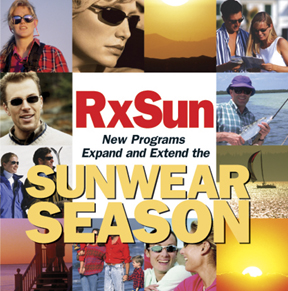
By Timothy Herrick
Contributing Editor
NEW YORK--Early spring used to be the start of the Rx sunwear season, but premium products have altered this annual cycle. Consumer and dispenser enthusiasm about designer frames and polarized lenses has transformed the prescription sunlens category into a more lucrative, higher-volume and year-round market.
"We used to diminish our sunwear inventory from October to March, but now we don't, because it is a 12-month business," said Robin Genden, owner/optician, Bayview Optometrics, Mashpee, Mass. "There's still a seasonal increase, but it's not as significant because we're selling more throughout the year."
"The women definitely buy all year," said Janie Blackstock, director of optical operations, Horizon Eye Care, Charlotte, N.C. "Men do as well, but the golfers and the fishermen, and the cyclists will buy more during what used to be sunwear season, which was around the end of March through July and August. Of course, in the winter months we have skiers buying sunwear, so that offsets any dip."
Sun Commitment
Eyecare professionals explain that the anticipated '05 Rx sunwear vigor has been the result of years of industrywide dedication. "About four years ago, I decided to make the commitment to sunwear," said Jay Binkowitz, owner/optician, America Eye Care Center, Astoria, N.Y. "I made an investment in the inventory and in training my personnel about the products. Frame companies also made their sun-line return policy more liberal, making it easier to keep up the stock all-year around, and of course, the polarized lens companies really improved their product and selection."
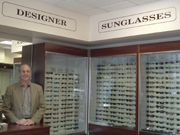 |
| Jay Binkowitz (above) of American Eye Care Center in Astoria, N.Y. (below), in his sun center. |
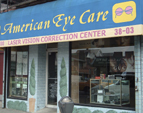 |
Increasing the frame selection also meant redefining how the category is merchandised. Chains like Sunglass Hut--as well as department stores featuring displays of designer sunglasses within fashion accessory departments--re-educated consumers about the product. Instead of treating the prescription market as an after-thought, dispensers gave the prescription sunwear market the same kind of attention as other retailers to meet the heightened consumer expectations of the category.
The main merchandising technique now used by Binkowitz--as well as other retailers interviewed for this article--is the creation of a "sun center," within the dispensary. These mini-boutiques follow the same strategy--cluster the sunwear frame inventory in an inviting display and situate the display prominently, generally at the front of the dispensary. "Sunwear draws people in, they're excited about the designers and they like to try them on," said Binkowitz. "Even people in for their regular ophthalmic eyewear will spend time at the display. Prescription sunglasses are the most likely second pair sale, even if it is a 'delayed reaction' second pair sale."
The foreground sunwear center positioning highlights the category within the dispensary. In addition, because this area is usually situated near the front windows--depending on the optical's design--it is the optimum location for product demonstration. "It's where the sunlight comes in," said Cleve Braham, owner/optician, Fine Eyes Eyewear, Ridgeland, Miss. "People always want to look into the mirror with glasses, and look out towards the glare, because that's what the glasses are used for."
Fun Merchandising
Dispensers augment the free-standing premium sunwear centers during the spring-to-summer spike in demand with thematic displays, which echo seasonal themes but are geared to draw attention to the frames. "I have some mini palm trees, bamboo, fake pineapples, little figurines of hula girls," said Braham. "It's fun. The focus, though, will be on the frames."
Genden also takes advantage of the upsurge by dedicating a window display with colorful ribbons, tasteful glass palm trees and other decorative accents with a summer motif. "The emphasis is on the design of the frames," said Genden.
Frame Names
Sunwear frame styles have never seemed more distinct from the general ophthalmic trends of smaller eye sizes and minimalist frames. Sunwear frame styles not only contrast this minimalist, toned-down look; but are also more gender defined. Leading women sunwear frames are best described as big and bold. Retro variations on the famed "Jackie O" look predominate, with plastic frames, in vibrant black or brown, as well as more colorful stripes or other print treatments.
Men's fashion is smaller than women's sunwear. "I see men buying more looks influenced by the sports glasses worn by athletes," added Blackstock. "I guess they're copying their celebrities."
One of the most vital segments of the sunwear market is the name-brand sunglass manufacturers that offer their own prescription lens program. Dispensers cite Maui Jim, Bolle, Oakley, Revo, and Serengeti as examples of influential brands and styles. Dispensers report that not only is consumer recognition of these names a crucial factor driving sales, but their frame designs continue to influence the overall style trends within the category. Perhaps as significant however, has been a marked improvement in the lens side of this high-end niche. "The manufacturers can fill a wider range of prescriptions, and they offer progressives and other designs," said Braham. "And the turnaround time is now a week or less, which makes a big difference for scheduling customers."
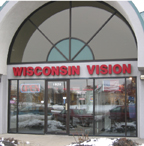 |
| This Wisconsin Vision Center's Milwaukee location (above) puts its sun center (below) in a prominent location. |
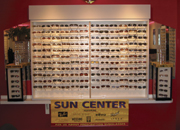 |
Whether men's or women's, the name-brand recognition of sunwear frame designers--and those designers increasing their offerings of ophthalmic quality models--has been a driving force in prescription sunwear growth. At the 25-store chain, Wisconsin Vision, headquartered in Milwaukee, between 200 and 400 sunwear frames are inventoried, clustered together in one display. "Our rule is to make sure 70 percent of the designer frames are Rx-able," said Darren Horndasch, president/chief executive officer. "We can steer patients into the ophthalmic styles from our frame vendors, where the mark-ups are better and we know we can handle their prescription."
Three-piece mounted wrap eyewear retains a significant niche status.
Some dispensers say that the three-piece wrap sunwear demand, although still strong, has cooled. According to Binkowitz, he optimized the niche by training his staff to discourage patients with higher prescription powers away from three-piece sunwear wraps and by upgrading his on-site finishing lab to include new drilling systems. "I was sending them out, but too many would come back with the temples flared out, or the drill-positioning was off so the mounting would not remain stable," said Binkowitz. "We control the quality by doing it in-house."
Polarized Awareness
While the enormous name-brand recognition among consumers of sunwear frame designers has elevated attention, the consumer appeal of polarized lenses seems to be pushing the market. "Consumers know about the benefits of eliminating glare; they're asking dispensers for polarized," said Michael Palkovicz, president of I-See Optical, a wholesale lab in Blackwood, N.J.
"The plano sunglass market has been using polarized for a while now so consumers know it from trying on those frames," said Blackstock. "The frame manufactures have done a good job too, putting polarized in for the demo lenses in the ophthalmic frames."
Rising consumer demand for prescription polarized lenses is no lucky accident. It is the result of lens manufacturers improving the consistency, performance, and availability of lens designs, materials and power ranges. "Now you can have a full prescription range, progressives, and other multifocals," said Horndasch. "Polarized lenses don't de-laminate like they used to. All these things have made our opticians more comfortable dispensing polarized lenses. They know they can get them in the patient's lens design and Rx, and there won't be the problems of two or three years ago."
Polarized lenses have gone from cult lens to mainstream option. Once the exclusive domain of a handful of small lens companies specializing in the category and some token product offerings by larger lens vendors, this limited lens selection is a thing of the past. Nearly all major lens manufacturers have full polarized lens lines, including making available their most well-known designs, particularly progressives, other multifocals as well as aspheric lenses in polarized. "For progressives it has made a huge difference," said Palkovicz. "Not only can dispensers keep the patient in the same progressive design, but they can even offer the choice of a plastic or a high-index material, including polycarbonate."
"With the bigger frame styles now popular, the higher-index material reduces the thickness and the weight of some prescriptions," added Blackstock.
This availability has also modified how polarized is presented to the patient. "We can get the same lens design and often material in polarized," said Braham. "We say to the patient, 'would you like that in polarized?' and we don't have any worries about adaptation or availability."
The cost of polarized lenses typically ranges from $100 to $150 (retail) above the cost of non-polarized lens, often including a back-side AR coating. Binkowitz offers a lens add-on package for $89, which includes a sunlens tint. For an additional $89, the lens is polarized. "More than 60 percent of the sunlens sales are in polarized," said Binkowitz. "Consumers already know about the product, they're excited about polarized, so the conversation starts at a higher-level."
Dispensers also report that flash mirrored coatings have experienced a noticeable upswing as a polarized lens add-on. Silver, gold, and blue are out pacing the more neon tones. "Flash mirrors do bounce off the light, they do serve a function," said Genden. "It used to be just a young market. The younger customers are still going for the neon reds and greens. But more older patients are buying the flash-mirror coatings, so the more conservative colors are outpacing the neons."
The availability of frames in all shapes and sizes, more lens options in an expanded prescription range and more labs specializing in wraps is creating new opportunities for the optical market to increase sales of Rx sunwear, one of its most profitable product categories.
But Wait, There's More
Go here to see what's new in products, marketing, and materials available to ECPs to capitalize on Rx sunwear











